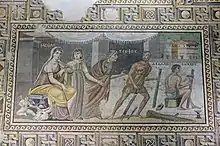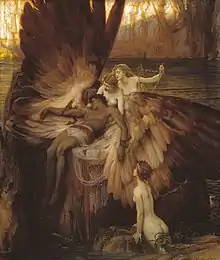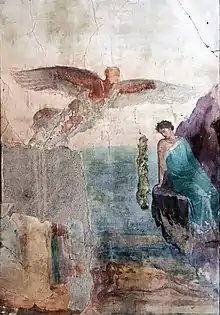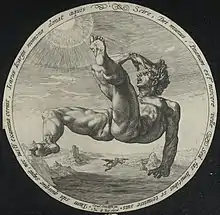Icarus
In Greek mythology, Icarus (/ˈɪkərəs/; Ancient Greek: Ἴκαρος, romanized: Íkaros, pronounced [ǐːkaros]) was the son of the master craftsman Daedalus, the creator of the Labyrinth. Icarus and Daedalus attempt to escape from Crete by means of wings that Daedalus constructed from feathers and wax. Daedalus warns Icarus first of complacency and then of hubris, instructing him to fly neither too low nor too high, lest the sea's dampness clog his wings or the sun's heat melt them.[1]Icarus ignores Daedalus’ instructions not to fly too close to the sun, causing the wax in his wings to melt. He falls out of the sky, plunges into the sea, and drowns. The myth gave rise to the idiom "don't fly too close to the sun".


The legend


Icarus's father Daedalus, a very talented Athenian craftsman, built the Labyrinth for King Minos of Crete near his palace at Knossos to imprison the Minotaur, a half-man, half-bull monster born of his wife and the Cretan bull. Minos imprisoned Daedalus himself in the labyrinth because he gave Minos's daughter, Ariadne, a clew[2] (or ball of string) in order to help Theseus, the enemy of Minos, to survive the Labyrinth and defeat the Minotaur.
Daedalus fashioned two pairs of wings out of wax and feathers for himself and his son. Before trying to escape the island, he warned his son not to fly too close to the sun, nor too close to the sea, but to follow his path of flight. Overcome by giddiness while flying, Icarus disobeyed his father and soared into the sky. He came too close to the sun, and the heat melted the wax holding his feathers together. One by one, Icarus's feathers fell, until he fell into the sea and drowned. Daedalus wept for his son and called the nearest land Icaria (an island southwest of Samos) in memory of him. Today, the supposed site of his burial on the island bears his name, and the sea near Icaria in which he drowned is called the Icarian Sea.[3][4][5] According to scholia on Euripides, Icarus fashioned himself greater than Helios the Sun himself, and the god punished him by directing his powerful rays at him, melting the wax. Afterwards, it was Helios who named the Icarian sea after Icarus.[6]

Hellenistic writers give euhemerising variants in which the escape from Crete was actually by boat, provided by Pasiphaë, for which Daedalus invented the first sails, to outstrip Minos' pursuing galleys, that Icarus fell overboard en route to Sicily and drowned, and that Heracles erected a tomb for him.[7][8]
Classical literature

Icarus' flight was often alluded to by Greek poets in passing, and was told briefly in Pseudo-Apollodorus.[9] Augustan writers who wrote about it in Latin include Hyginus, who tells in Fabula of the bovine love affair of Pasiphaë, daughter of the Sun, that resulted in the birth of the Minotaur, as well as Ovid, who tells the story of Icarus at some length in the Metamorphoses (viii.183–235), and refers to it elsewhere.[10]
Medieval, Renaissance, and modern literature
Ovid's treatment of the Icarus myth and its connection with that of Phaethon influenced the mythological tradition in English literature[11] as received and interpreted by major writers including Chaucer,[12] Marlowe,[13] Shakespeare,[14] Milton,[15] and Joyce.[16]
In Renaissance iconography, the significance of Icarus depends on context: in the Orion Fountain at Messina, he is one of many figures associated with water; but he is also shown on the Bankruptcy Court of the Amsterdam Town Hall – where he symbolizes high-flying ambition.[17] The 16th-century painting Landscape with the Fall of Icarus, traditionally (but perhaps erroneously[18][19]) attributed to Pieter Bruegel the Elder, was the inspiration for two of the 20th century's most notable ecphrastic English-language poems, "Musée des Beaux Arts" by W. H. Auden and "Landscape with the Fall of Icarus" by William Carlos Williams. Other English-language poems referencing the Icarus myth are "To a Friend Whose Work Has Come to Triumph" by Anne Sexton; "Icarus Again" by Alan Devenish; "Mrs Icarus" by Carol Ann Duffy; "Failing and Flying" by Jack Gilbert; "It Should Have Been Winter" by Nancy Chen Long; "Icarus Burning" and "Icarus Redux" by Hiromi Yoshida; and "Up like Icarus" by syllabic poet Mark Antony Owen. The Norwegian Axel Jensen used Icarus as a metaphor for troubled modern young men, in the 1957 novel Icarus: A Young Man in Sahara.
 A 16th century print of Icarus falling.[20]
A 16th century print of Icarus falling.[20] In Bruegel's Landscape with the Fall of Icarus (c. 1558) the fallen Icarus is a small detail at lower right.
In Bruegel's Landscape with the Fall of Icarus (c. 1558) the fallen Icarus is a small detail at lower right. Modern street art of Icaria island and falling Icarus just outside the village of Evdilos on Icaria, Greece
Modern street art of Icaria island and falling Icarus just outside the village of Evdilos on Icaria, Greece
Interpretation

Literary interpretation has found in the myth the structure and consequence of personal over-ambition.[21] An Icarus-related study of the Daedalus myth was published by the French hellenist Françoise Frontisi-Ducroux.[22] In psychology, there have been synthetic studies of the Icarus complex with respect to the alleged relationship between fascination for fire, enuresis, high ambition, and ascensionism.[23] In the psychiatric mind features of disease were perceived in the shape of the pendulous emotional ecstatic-high and depressive-low of bipolar disorder. Henry Murray having proposed the term Icarus complex, apparently found symptoms particularly in mania where a person is fond of heights, fascinated by both fire and water, narcissistic and observed with fantastical or far-fetched imaginary cognition.[24][25] Seth Godin's 2012 The Icarus Deception points to the historical change in how Western culture both propagated and interpreted the Icarus myth arguing that "we tend to forget that Icarus was also warned not to fly too low, because seawater would ruin the lift in his wings. Flying too low is even more dangerous than flying too high, because it feels deceptively safe."[26]
See also
- Bladud, a legendary king of the Britons, purported to have met his death when his constructed wings failed
- Etana, a sort of "Babylonian Icarus"[27]
- Icarus imagery in contemporary music
- Kua Fu, a Chinese myth about a giant who chased the sun and died while getting too close
- Sampati, an Indian myth about a bird which lost its wings while trying to save its younger brother from the sun
References
- "CommonLit | The Myth of Daedalus and Icarus by Ovid". CommonLit. Retrieved 17 October 2022.
- clew – a ball of yarn or thread. The etymology of the word "clue" is a direct reference to this story of the Labyrinth.
- Graves, Robert (1955). "92 – Daedalus and Talus". The Greek Myths. ISBN 0-14-007602-6.
- Thomas Bullfinch - The Age of Fable Stories of Gods and Heroes KundaliniAwakeningSystem.com & The Internet Classics Archive by Daniel C. Stevenson : Ovid - Metamorphoses - Book VIII + Translated by Rolfe Humphries - KET Distance Learning Archived 14 June 2012 at the Wayback Machine 2012-01-24.
- Translated by A. S. Kline - University of Virginia Library.edu Retrieved 2005-07-03.
- Mastronarde, Donald J. (2017). Preliminary Studies On the Scholia to Euripides (PDF). Berkeley, California: California Classical Studies. pp. 149–150. ISBN 9781939926104.
- Smith, William, ed. (1867). A Dictionary of Greek and Roman Biography and Mythology.
- Pinsent, J. (1982). Greek Mythology. New York: Peter Bedrick Books. ISBN 0-600-55023-0.
- Epitome of the Biblioteca i.11 and ii.6.3.
- Gareth D. Williams, Banished voices: readings in Ovid's Exile Poetry (Cambridge University Press, 1994), p. 132 online.
- Peter Knox, A Companion to Ovid (Blackwell, 2009), p. 424 online.
- Jane Chance, The Mythographic Chaucer (University of Michigan Press, 1995), p. 65 online.
- Troni Y. Grande, Marlovian Tragedy (Associated University Presses, 1990), pp. 14 online, 40–42 et passim; Frederic B. Tromly, Playing with Desire: Christopher Tantalization (University of Toronto Press, 1998), p. 181.
- Coppélia Kahn, Man's estate: Masculine Identity in Shakespeare (University of California Press, 1981), p. 53 online.
- Su Fang Nu, Literature and the Politics of Family in Seventeenth-Century England (Cambridge University Press, 2007), p. 154 online; R.J. Zwi Werblowsky, Lucifer and Prometheus (Routledge, 2001, reprinted from 1952), p. 32 online.
- R. J. Schork, Latin and Roman Culture in Joyce (University Press of Florida, 1997), p. 160 online.
- E. H. Gombrich, Symbolic Images; Studies in the Art of the Renaissance (London, 1972); p. 8.
- "On doute que l'exécution soit de Pieter I Bruegel mais la conception Lui est par contre attribuée avec certitude", Royal Museums of Fine Arts of Belgium. "Description détaillée" (in French). Archived from the original on 27 March 2012. Retrieved 3 September 2011.
- de Vries, Lyckle (2003). "Bruegel's "Fall of Icarus": Ovid or Solomon?". Simiolus: Netherlands Quarterly for the History of Art. Stichting voor Nederlandse Kunsthistorische Publicaties. 30 (1/2): 4–18. JSTOR 3780948.
- "De val van Icarus". lib.ugent.be. Retrieved 2 October 2020.
- Jacob E. Nyenhuis - Myth and the creative process: Michael Ayrton and the myth of Daedalus, the maze maker - 345 pages Wayne State University Press, 2003 Retrieved 2012-01-24 ISBN 0-8143-3002-9 See also Harry Levin, The Overreacher, Harvard University Press, 1952
- Frontisi-Ducroux, Françoise (1975). Dédale: Mythologie de l'artisan en Grèce Ancienne. Paris: François Maspero. p. 227.
- Wiklund, Nils (1978). The icarus complex. Lund: Doxa. ISBN 91-578-0064-2.
- Michael Sperber 2010 - Dostoyevsky's Stalker and Other Essays on Psychopathology and the Arts, University Press of America, 2010, p. 166 ff, ISBN 0-7618-4993-9
- Pendulum - The BiPolar Organisation's quarterly journal Bipolar UK Retrieved 2012-01-24.
- Godin, Seth (2012). The Icarus Deception: How High Will You Fly? (1st ed.). Portfolio.
- Comparison noted by W.H.Ph. Römer, "Religion of Ancient Mesopotamia," in Historia Religionum: Religions of the Past (Brill, 1969), vol. 1, p. 163.
Further reading
- Graves, Robert, (1955) 1960. The Greek Myths, section 92 passim
- Pinsent, J. (1982). Greek Mythology. New York: Peter Bedrick Books
- Smith, William, ed. A Dictionary of Greek and Roman Biography and Mythology